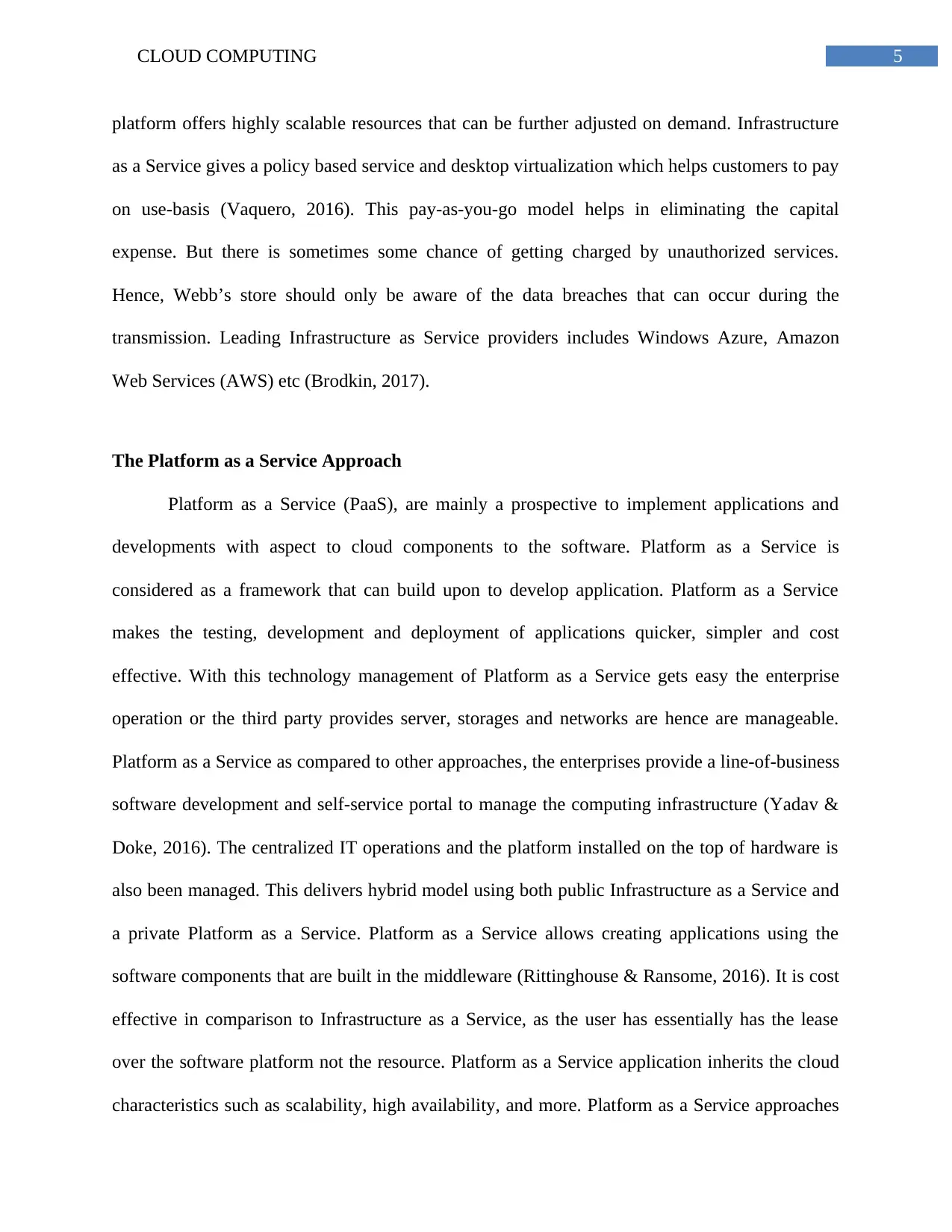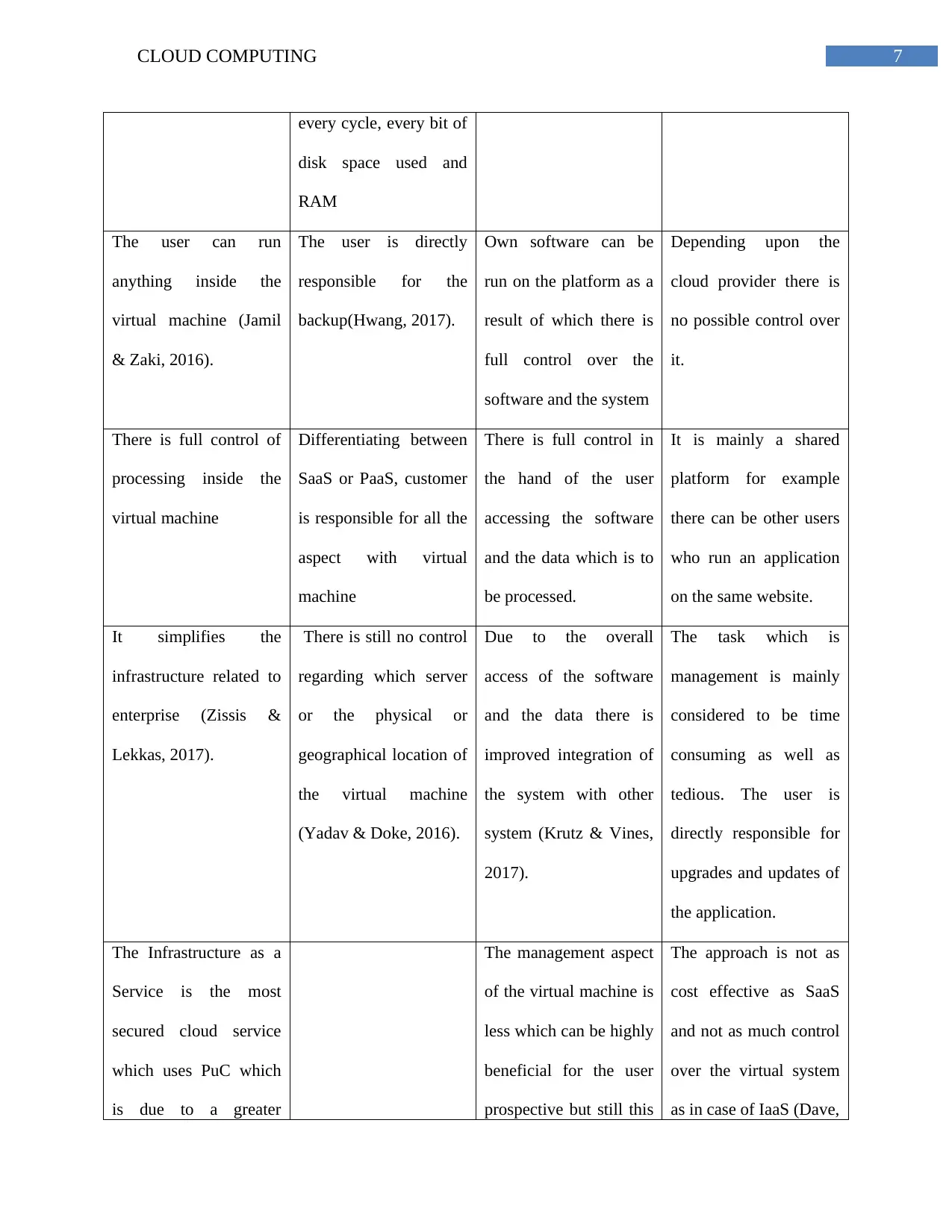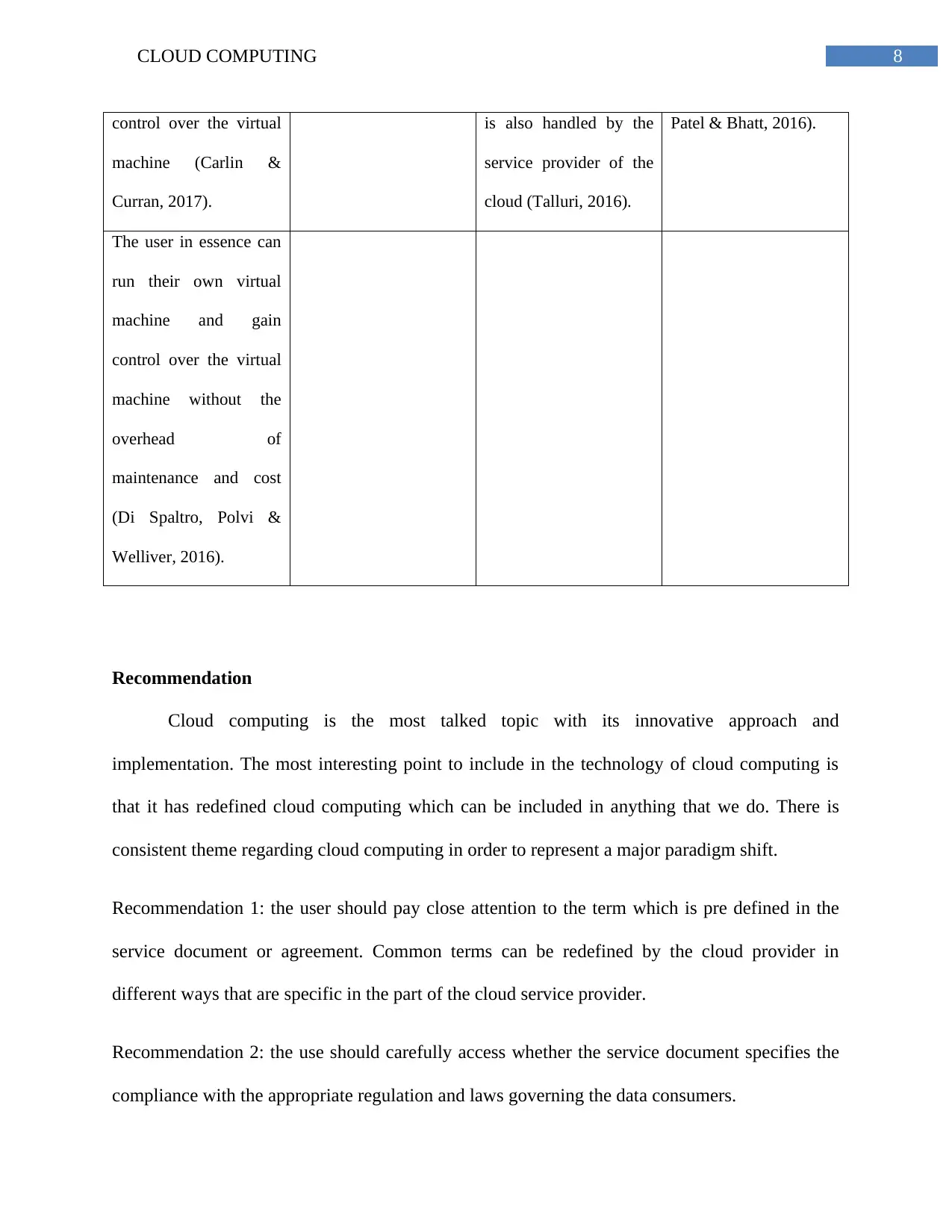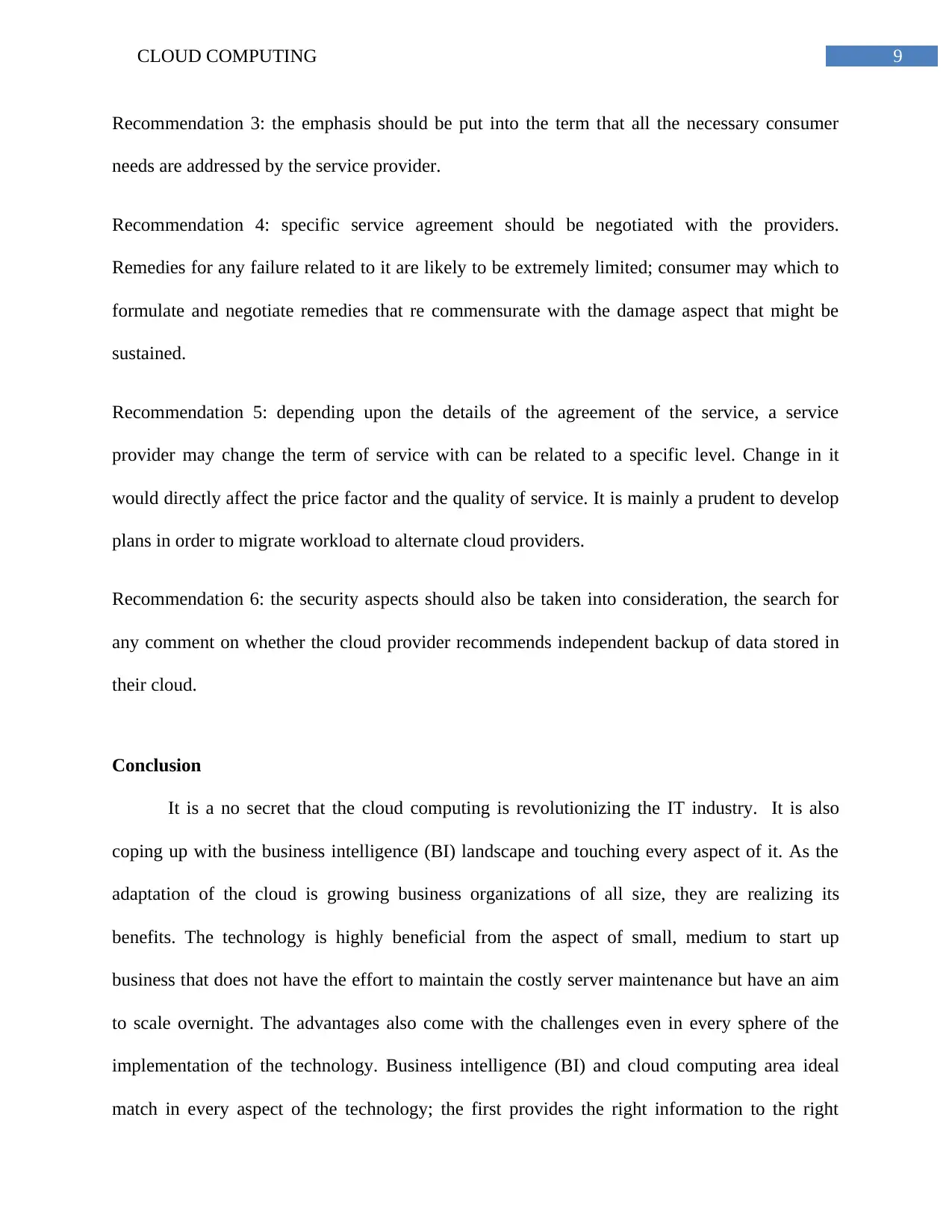Comparative Analysis of Cloud Computing Services: IaaS vs. PaaS Report
VerifiedAdded on 2020/03/07
|11
|2770
|52
Report
AI Summary
This report provides an in-depth analysis of cloud computing, focusing on two key service models: Infrastructure as a Service (IaaS) and Platform as a Service (PaaS). The introduction defines cloud computing and its role in IT, emphasizing its decentralized nature and remote resource provisioning. The report then delves into IaaS, explaining its virtualization of computing resources, self-service model, and user responsibilities. It highlights advantages like scalability and pay-as-you-go pricing, while also noting potential drawbacks like cost and security considerations. Following this, the report examines PaaS, describing its framework for application development and deployment, cost-effectiveness, and scalability. It also points out disadvantages, such as limited control over the platform and potential security issues. The report concludes with a comparison of the advantages and disadvantages of both approaches, offering recommendations for users and emphasizing the revolutionary impact of cloud computing on the IT industry, including its alignment with business intelligence and the need for careful service agreements and security considerations. The report is available on Desklib, a platform providing AI-based study tools and resources for students.

Running head: CLOUD COMPUTING
CLOUD COMPUTING
Name of the Student
Name of the University
Author Note
CLOUD COMPUTING
Name of the Student
Name of the University
Author Note
Paraphrase This Document
Need a fresh take? Get an instant paraphrase of this document with our AI Paraphraser

2CLOUD COMPUTING
Table of Contents
Introduction......................................................................................................................................3
The Infrastructure as a Service Approach.......................................................................................3
The Platform as a Service Approach...............................................................................................4
Recommendation.............................................................................................................................6
Conclusion.......................................................................................................................................6
References........................................................................................................................................8
Table of Contents
Introduction......................................................................................................................................3
The Infrastructure as a Service Approach.......................................................................................3
The Platform as a Service Approach...............................................................................................4
Recommendation.............................................................................................................................6
Conclusion.......................................................................................................................................6
References........................................................................................................................................8

3CLOUD COMPUTING
Introduction
A cloud computing refers to a distinct environment related to information technology that
mainly for the purpose of provisioning remotely measured and scalable Information technology
resources. The term cloud computing is a metaphor for the internet which is in essence, a
network of network which mainly provide access by means of remote position of information
technology resources that is decentralized (Xia et al., 2016). Earlier cloud was represented to as
an internet in a mainstream documentation and variety of application. Clouds can be used as a
service which can be easily be distinguishable and used for a variety of service which is needed
by the organization. It is very much essential to distinguish the term cloud and the symbol
associated with it. A cloud has a finite boundary as a specific environment used in remote
provision of information technology resources. There are wide ranges of cloud used that can be
accessible through the internet. The internet provides open access to the internet to many
resource which is it based upon, a cloud is typically private owned and offers IT resources access
that can be measured (Hwang, 2017). The internet is mainly formed to give access to the IT
based content which is published via the World Wide Web (www). the It resources that are
provided by the cloud computing are dedicated to supply user based access to the capabilities
with respect to the technology and processing which is related to the back end. An important
factor is that the cloud doesn’t allow have to be necessarily webbed based even though it might
consist of internet protocols and technologies. The term protocols can be referred to methods and
standard that allows the computer to communicate with each other in s structured and pre-
defined method. The cloud can be based on the use of any of the It resources which can be
accessed remotely (Rittinghouse & Ransome, 2016).
Introduction
A cloud computing refers to a distinct environment related to information technology that
mainly for the purpose of provisioning remotely measured and scalable Information technology
resources. The term cloud computing is a metaphor for the internet which is in essence, a
network of network which mainly provide access by means of remote position of information
technology resources that is decentralized (Xia et al., 2016). Earlier cloud was represented to as
an internet in a mainstream documentation and variety of application. Clouds can be used as a
service which can be easily be distinguishable and used for a variety of service which is needed
by the organization. It is very much essential to distinguish the term cloud and the symbol
associated with it. A cloud has a finite boundary as a specific environment used in remote
provision of information technology resources. There are wide ranges of cloud used that can be
accessible through the internet. The internet provides open access to the internet to many
resource which is it based upon, a cloud is typically private owned and offers IT resources access
that can be measured (Hwang, 2017). The internet is mainly formed to give access to the IT
based content which is published via the World Wide Web (www). the It resources that are
provided by the cloud computing are dedicated to supply user based access to the capabilities
with respect to the technology and processing which is related to the back end. An important
factor is that the cloud doesn’t allow have to be necessarily webbed based even though it might
consist of internet protocols and technologies. The term protocols can be referred to methods and
standard that allows the computer to communicate with each other in s structured and pre-
defined method. The cloud can be based on the use of any of the It resources which can be
accessed remotely (Rittinghouse & Ransome, 2016).
⊘ This is a preview!⊘
Do you want full access?
Subscribe today to unlock all pages.

Trusted by 1+ million students worldwide

4CLOUD COMPUTING
The report mainly puts emphasis on the different services of cloud computing. The main
lime light would be put on the Infrastructure as a Service approach and the PaaS approach,
taking into account the various advantage and disadvantage related to the approach.
The Infrastructure as a Service Approach
Infrastructure as a Service (IaaS) is a kind of cloud computing that provides virtualizes
the computing resources over the internet. IT is a self-service model that accesses, monitors and
manages the remote datacenter infrastructure, such as computer that is virtualized, storage,
network or networking services like firewalls (Hwang, 2017). User can purchase Infrastructure
as a Service instead of buying hardware outright based on the consumption it has. Comparing
Infrastructure as Service users to other approaches, this method is responsible for managing data,
middleware, applications, and runtime and OS systems. Infrastructure as a Service providers
offer database systems, messaging query, servers, hard drives and networks above the
virtualization layer. User can install the required platform with Infrastructure as a Service
infrastructure on top. The management aspect of the virtual machine is less which can be highly
beneficial for the user prospective but still this is also handled by the service provider of the
cloud (Talluri, 2016). The user should pay close attention to the term which is pre defined in the
service document or agreement. Common terms can be redefined by the cloud provider in
different ways that are specific in the part of the cloud service provider.
But if new versions are available the users are themselves responsible for updating the
system. An Infrastructure as a Service approach to migrate the Webb’s database to the cloud is a
good approach since in Infrastructure as a Service system maintenance is automatic and handles
tasks like backup and resiliency planning (Kachele et al., 2017). Infrastructure as a Service
The report mainly puts emphasis on the different services of cloud computing. The main
lime light would be put on the Infrastructure as a Service approach and the PaaS approach,
taking into account the various advantage and disadvantage related to the approach.
The Infrastructure as a Service Approach
Infrastructure as a Service (IaaS) is a kind of cloud computing that provides virtualizes
the computing resources over the internet. IT is a self-service model that accesses, monitors and
manages the remote datacenter infrastructure, such as computer that is virtualized, storage,
network or networking services like firewalls (Hwang, 2017). User can purchase Infrastructure
as a Service instead of buying hardware outright based on the consumption it has. Comparing
Infrastructure as Service users to other approaches, this method is responsible for managing data,
middleware, applications, and runtime and OS systems. Infrastructure as a Service providers
offer database systems, messaging query, servers, hard drives and networks above the
virtualization layer. User can install the required platform with Infrastructure as a Service
infrastructure on top. The management aspect of the virtual machine is less which can be highly
beneficial for the user prospective but still this is also handled by the service provider of the
cloud (Talluri, 2016). The user should pay close attention to the term which is pre defined in the
service document or agreement. Common terms can be redefined by the cloud provider in
different ways that are specific in the part of the cloud service provider.
But if new versions are available the users are themselves responsible for updating the
system. An Infrastructure as a Service approach to migrate the Webb’s database to the cloud is a
good approach since in Infrastructure as a Service system maintenance is automatic and handles
tasks like backup and resiliency planning (Kachele et al., 2017). Infrastructure as a Service
Paraphrase This Document
Need a fresh take? Get an instant paraphrase of this document with our AI Paraphraser

5CLOUD COMPUTING
platform offers highly scalable resources that can be further adjusted on demand. Infrastructure
as a Service gives a policy based service and desktop virtualization which helps customers to pay
on use-basis (Vaquero, 2016). This pay-as-you-go model helps in eliminating the capital
expense. But there is sometimes some chance of getting charged by unauthorized services.
Hence, Webb’s store should only be aware of the data breaches that can occur during the
transmission. Leading Infrastructure as Service providers includes Windows Azure, Amazon
Web Services (AWS) etc (Brodkin, 2017).
The Platform as a Service Approach
Platform as a Service (PaaS), are mainly a prospective to implement applications and
developments with aspect to cloud components to the software. Platform as a Service is
considered as a framework that can build upon to develop application. Platform as a Service
makes the testing, development and deployment of applications quicker, simpler and cost
effective. With this technology management of Platform as a Service gets easy the enterprise
operation or the third party provides server, storages and networks are hence are manageable.
Platform as a Service as compared to other approaches, the enterprises provide a line-of-business
software development and self-service portal to manage the computing infrastructure (Yadav &
Doke, 2016). The centralized IT operations and the platform installed on the top of hardware is
also been managed. This delivers hybrid model using both public Infrastructure as a Service and
a private Platform as a Service. Platform as a Service allows creating applications using the
software components that are built in the middleware (Rittinghouse & Ransome, 2016). It is cost
effective in comparison to Infrastructure as a Service, as the user has essentially has the lease
over the software platform not the resource. Platform as a Service application inherits the cloud
characteristics such as scalability, high availability, and more. Platform as a Service approaches
platform offers highly scalable resources that can be further adjusted on demand. Infrastructure
as a Service gives a policy based service and desktop virtualization which helps customers to pay
on use-basis (Vaquero, 2016). This pay-as-you-go model helps in eliminating the capital
expense. But there is sometimes some chance of getting charged by unauthorized services.
Hence, Webb’s store should only be aware of the data breaches that can occur during the
transmission. Leading Infrastructure as Service providers includes Windows Azure, Amazon
Web Services (AWS) etc (Brodkin, 2017).
The Platform as a Service Approach
Platform as a Service (PaaS), are mainly a prospective to implement applications and
developments with aspect to cloud components to the software. Platform as a Service is
considered as a framework that can build upon to develop application. Platform as a Service
makes the testing, development and deployment of applications quicker, simpler and cost
effective. With this technology management of Platform as a Service gets easy the enterprise
operation or the third party provides server, storages and networks are hence are manageable.
Platform as a Service as compared to other approaches, the enterprises provide a line-of-business
software development and self-service portal to manage the computing infrastructure (Yadav &
Doke, 2016). The centralized IT operations and the platform installed on the top of hardware is
also been managed. This delivers hybrid model using both public Infrastructure as a Service and
a private Platform as a Service. Platform as a Service allows creating applications using the
software components that are built in the middleware (Rittinghouse & Ransome, 2016). It is cost
effective in comparison to Infrastructure as a Service, as the user has essentially has the lease
over the software platform not the resource. Platform as a Service application inherits the cloud
characteristics such as scalability, high availability, and more. Platform as a Service approaches

6CLOUD COMPUTING
to migrate Webb’s database to the cloud, but the greatest disadvantage would be its not having
any control over the platforms depending on cloud provider. There is a security issue as there is
no record of the database transferred. This is a shared platform hence takes time as compared to
other approaches. Less cost effective make the platform unusable for the Webb’s store
organization since cost managing is the biggest task in any retailer store (Almorsy, Grundy &
Müller, 2016).
In a cloud computing process there always lies the advantages also come with the
challenges even. Business intelligence (BI) and cloud computing area ideal match in every aspect
of the technology; the first provides the right information to the right people at the right time
while the other is an agile way in order to access the BI applications. To make the best out of the
technology strategic iterative approach to the implementation in order to explore hybrid solution
of the cloud this involves the business and the IT teams.
Advantage and Disadvantage Of Each Approach
Infrastructure as a Service (IaaS) Platform as a Service (PaaS)
Advantage Disadvantage Advantage Disadvantage
The user has full control
over the virtual machine
and everything related
to it. They can build
their own virtual
machine or automate the
provision.
Infrastructure as a
Service is the most
expensive approach,
since with respect to the
customer is now leasing
a resource which is
tangible. The cloud
provider charge for
It is cost effective in
comparison to
Infrastructure as a
Service, as the user has
essentially has the lease
over the software
platform not the
resource
There is no information
about the data as there is
no full control over the
virtual machine or the
data which is to be
processed.
to migrate Webb’s database to the cloud, but the greatest disadvantage would be its not having
any control over the platforms depending on cloud provider. There is a security issue as there is
no record of the database transferred. This is a shared platform hence takes time as compared to
other approaches. Less cost effective make the platform unusable for the Webb’s store
organization since cost managing is the biggest task in any retailer store (Almorsy, Grundy &
Müller, 2016).
In a cloud computing process there always lies the advantages also come with the
challenges even. Business intelligence (BI) and cloud computing area ideal match in every aspect
of the technology; the first provides the right information to the right people at the right time
while the other is an agile way in order to access the BI applications. To make the best out of the
technology strategic iterative approach to the implementation in order to explore hybrid solution
of the cloud this involves the business and the IT teams.
Advantage and Disadvantage Of Each Approach
Infrastructure as a Service (IaaS) Platform as a Service (PaaS)
Advantage Disadvantage Advantage Disadvantage
The user has full control
over the virtual machine
and everything related
to it. They can build
their own virtual
machine or automate the
provision.
Infrastructure as a
Service is the most
expensive approach,
since with respect to the
customer is now leasing
a resource which is
tangible. The cloud
provider charge for
It is cost effective in
comparison to
Infrastructure as a
Service, as the user has
essentially has the lease
over the software
platform not the
resource
There is no information
about the data as there is
no full control over the
virtual machine or the
data which is to be
processed.
⊘ This is a preview!⊘
Do you want full access?
Subscribe today to unlock all pages.

Trusted by 1+ million students worldwide

7CLOUD COMPUTING
every cycle, every bit of
disk space used and
RAM
The user can run
anything inside the
virtual machine (Jamil
& Zaki, 2016).
The user is directly
responsible for the
backup(Hwang, 2017).
Own software can be
run on the platform as a
result of which there is
full control over the
software and the system
Depending upon the
cloud provider there is
no possible control over
it.
There is full control of
processing inside the
virtual machine
Differentiating between
SaaS or PaaS, customer
is responsible for all the
aspect with virtual
machine
There is full control in
the hand of the user
accessing the software
and the data which is to
be processed.
It is mainly a shared
platform for example
there can be other users
who run an application
on the same website.
It simplifies the
infrastructure related to
enterprise (Zissis &
Lekkas, 2017).
There is still no control
regarding which server
or the physical or
geographical location of
the virtual machine
(Yadav & Doke, 2016).
Due to the overall
access of the software
and the data there is
improved integration of
the system with other
system (Krutz & Vines,
2017).
The task which is
management is mainly
considered to be time
consuming as well as
tedious. The user is
directly responsible for
upgrades and updates of
the application.
The Infrastructure as a
Service is the most
secured cloud service
which uses PuC which
is due to a greater
The management aspect
of the virtual machine is
less which can be highly
beneficial for the user
prospective but still this
The approach is not as
cost effective as SaaS
and not as much control
over the virtual system
as in case of IaaS (Dave,
every cycle, every bit of
disk space used and
RAM
The user can run
anything inside the
virtual machine (Jamil
& Zaki, 2016).
The user is directly
responsible for the
backup(Hwang, 2017).
Own software can be
run on the platform as a
result of which there is
full control over the
software and the system
Depending upon the
cloud provider there is
no possible control over
it.
There is full control of
processing inside the
virtual machine
Differentiating between
SaaS or PaaS, customer
is responsible for all the
aspect with virtual
machine
There is full control in
the hand of the user
accessing the software
and the data which is to
be processed.
It is mainly a shared
platform for example
there can be other users
who run an application
on the same website.
It simplifies the
infrastructure related to
enterprise (Zissis &
Lekkas, 2017).
There is still no control
regarding which server
or the physical or
geographical location of
the virtual machine
(Yadav & Doke, 2016).
Due to the overall
access of the software
and the data there is
improved integration of
the system with other
system (Krutz & Vines,
2017).
The task which is
management is mainly
considered to be time
consuming as well as
tedious. The user is
directly responsible for
upgrades and updates of
the application.
The Infrastructure as a
Service is the most
secured cloud service
which uses PuC which
is due to a greater
The management aspect
of the virtual machine is
less which can be highly
beneficial for the user
prospective but still this
The approach is not as
cost effective as SaaS
and not as much control
over the virtual system
as in case of IaaS (Dave,
Paraphrase This Document
Need a fresh take? Get an instant paraphrase of this document with our AI Paraphraser

8CLOUD COMPUTING
control over the virtual
machine (Carlin &
Curran, 2017).
is also handled by the
service provider of the
cloud (Talluri, 2016).
Patel & Bhatt, 2016).
The user in essence can
run their own virtual
machine and gain
control over the virtual
machine without the
overhead of
maintenance and cost
(Di Spaltro, Polvi &
Welliver, 2016).
Recommendation
Cloud computing is the most talked topic with its innovative approach and
implementation. The most interesting point to include in the technology of cloud computing is
that it has redefined cloud computing which can be included in anything that we do. There is
consistent theme regarding cloud computing in order to represent a major paradigm shift.
Recommendation 1: the user should pay close attention to the term which is pre defined in the
service document or agreement. Common terms can be redefined by the cloud provider in
different ways that are specific in the part of the cloud service provider.
Recommendation 2: the use should carefully access whether the service document specifies the
compliance with the appropriate regulation and laws governing the data consumers.
control over the virtual
machine (Carlin &
Curran, 2017).
is also handled by the
service provider of the
cloud (Talluri, 2016).
Patel & Bhatt, 2016).
The user in essence can
run their own virtual
machine and gain
control over the virtual
machine without the
overhead of
maintenance and cost
(Di Spaltro, Polvi &
Welliver, 2016).
Recommendation
Cloud computing is the most talked topic with its innovative approach and
implementation. The most interesting point to include in the technology of cloud computing is
that it has redefined cloud computing which can be included in anything that we do. There is
consistent theme regarding cloud computing in order to represent a major paradigm shift.
Recommendation 1: the user should pay close attention to the term which is pre defined in the
service document or agreement. Common terms can be redefined by the cloud provider in
different ways that are specific in the part of the cloud service provider.
Recommendation 2: the use should carefully access whether the service document specifies the
compliance with the appropriate regulation and laws governing the data consumers.

9CLOUD COMPUTING
Recommendation 3: the emphasis should be put into the term that all the necessary consumer
needs are addressed by the service provider.
Recommendation 4: specific service agreement should be negotiated with the providers.
Remedies for any failure related to it are likely to be extremely limited; consumer may which to
formulate and negotiate remedies that re commensurate with the damage aspect that might be
sustained.
Recommendation 5: depending upon the details of the agreement of the service, a service
provider may change the term of service with can be related to a specific level. Change in it
would directly affect the price factor and the quality of service. It is mainly a prudent to develop
plans in order to migrate workload to alternate cloud providers.
Recommendation 6: the security aspects should also be taken into consideration, the search for
any comment on whether the cloud provider recommends independent backup of data stored in
their cloud.
Conclusion
It is a no secret that the cloud computing is revolutionizing the IT industry. It is also
coping up with the business intelligence (BI) landscape and touching every aspect of it. As the
adaptation of the cloud is growing business organizations of all size, they are realizing its
benefits. The technology is highly beneficial from the aspect of small, medium to start up
business that does not have the effort to maintain the costly server maintenance but have an aim
to scale overnight. The advantages also come with the challenges even in every sphere of the
implementation of the technology. Business intelligence (BI) and cloud computing area ideal
match in every aspect of the technology; the first provides the right information to the right
Recommendation 3: the emphasis should be put into the term that all the necessary consumer
needs are addressed by the service provider.
Recommendation 4: specific service agreement should be negotiated with the providers.
Remedies for any failure related to it are likely to be extremely limited; consumer may which to
formulate and negotiate remedies that re commensurate with the damage aspect that might be
sustained.
Recommendation 5: depending upon the details of the agreement of the service, a service
provider may change the term of service with can be related to a specific level. Change in it
would directly affect the price factor and the quality of service. It is mainly a prudent to develop
plans in order to migrate workload to alternate cloud providers.
Recommendation 6: the security aspects should also be taken into consideration, the search for
any comment on whether the cloud provider recommends independent backup of data stored in
their cloud.
Conclusion
It is a no secret that the cloud computing is revolutionizing the IT industry. It is also
coping up with the business intelligence (BI) landscape and touching every aspect of it. As the
adaptation of the cloud is growing business organizations of all size, they are realizing its
benefits. The technology is highly beneficial from the aspect of small, medium to start up
business that does not have the effort to maintain the costly server maintenance but have an aim
to scale overnight. The advantages also come with the challenges even in every sphere of the
implementation of the technology. Business intelligence (BI) and cloud computing area ideal
match in every aspect of the technology; the first provides the right information to the right
⊘ This is a preview!⊘
Do you want full access?
Subscribe today to unlock all pages.

Trusted by 1+ million students worldwide

10CLOUD COMPUTING
people at the right time while the other is an agile way in order to access the BI applications. To
make the best out of the technology strategic iterative approach to the implementation in order to
explore hybrid solution of the cloud this involves the business and the IT teams.
people at the right time while the other is an agile way in order to access the BI applications. To
make the best out of the technology strategic iterative approach to the implementation in order to
explore hybrid solution of the cloud this involves the business and the IT teams.
Paraphrase This Document
Need a fresh take? Get an instant paraphrase of this document with our AI Paraphraser

11CLOUD COMPUTING
References
Almorsy, M., Grundy, J., & Müller, I. (2016). An analysis of the cloud computing security
problem. arXiv preprint arXiv:1609.01107.
Brodkin, J. (2017). Gartner: Seven cloud-computing security risks. Infoworld, 2008, 1-3.
Carlin, S., & Curran, K. (2017). Cloud computing security.
Dave, A., Patel, B., & Bhatt, G. (2016, October). Load balancing in cloud computing using
optimization techniques: A study. In Communication and Electronics Systems (ICCES),
International Conference on (pp. 1-6). IEEE.
Di Spaltro, D., Polvi, A., & Welliver, L. (2016). U.S. Patent No. 9,501,329. Washington, DC:
U.S. Patent and Trademark Office.
Hwang, K. (2017). Cloud and Cognitive Computing: Principles, Architecture, Programming.
MIT Press.
Jamil, D., & Zaki, H. (2016). Cloud computing security. International Journal of Engineering
Science and Technology, 3(4).
Kachele, S., Spann, C., Hauck, F. J., & Domaschka, J. (2013, December). Beyond IaaS and
PaaS: An extended cloud taxonomy for computation, storage and networking. In Utility
and Cloud Computing (UCC), 2013 IEEE/ACM 6th International Conference on (pp. 75-
82). IEEE.
Krutz, R. L., & Vines, R. D. (2017). Cloud security: A comprehensive guide to secure cloud
computing. Wiley Publishing.
References
Almorsy, M., Grundy, J., & Müller, I. (2016). An analysis of the cloud computing security
problem. arXiv preprint arXiv:1609.01107.
Brodkin, J. (2017). Gartner: Seven cloud-computing security risks. Infoworld, 2008, 1-3.
Carlin, S., & Curran, K. (2017). Cloud computing security.
Dave, A., Patel, B., & Bhatt, G. (2016, October). Load balancing in cloud computing using
optimization techniques: A study. In Communication and Electronics Systems (ICCES),
International Conference on (pp. 1-6). IEEE.
Di Spaltro, D., Polvi, A., & Welliver, L. (2016). U.S. Patent No. 9,501,329. Washington, DC:
U.S. Patent and Trademark Office.
Hwang, K. (2017). Cloud and Cognitive Computing: Principles, Architecture, Programming.
MIT Press.
Jamil, D., & Zaki, H. (2016). Cloud computing security. International Journal of Engineering
Science and Technology, 3(4).
Kachele, S., Spann, C., Hauck, F. J., & Domaschka, J. (2013, December). Beyond IaaS and
PaaS: An extended cloud taxonomy for computation, storage and networking. In Utility
and Cloud Computing (UCC), 2013 IEEE/ACM 6th International Conference on (pp. 75-
82). IEEE.
Krutz, R. L., & Vines, R. D. (2017). Cloud security: A comprehensive guide to secure cloud
computing. Wiley Publishing.
1 out of 11
Related Documents
Your All-in-One AI-Powered Toolkit for Academic Success.
+13062052269
info@desklib.com
Available 24*7 on WhatsApp / Email
![[object Object]](/_next/static/media/star-bottom.7253800d.svg)
Unlock your academic potential
Copyright © 2020–2025 A2Z Services. All Rights Reserved. Developed and managed by ZUCOL.




